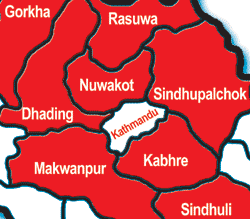 The Maoist strategy to strangle Kathmandu with a military buildup in the surrounding districts of Rasuwa, Nuwakot, Dhading and parts of Gorkha, Sindhupalchok, Kabhre and Makwanpur has suffered setbacks. The reason is the increased efficacy of the army's intelligence in recent months, which has allowed key leaders to be captured and killed. The leaders of the 'Ring Area' used to be Hit Bahadur Tamang and Bharat Dhungana. Tamang was among the 11 Maoist leaders captured by Indian police in Patna in May and Dhungana was killed in an army action in Dhading last month.
The Maoist strategy to strangle Kathmandu with a military buildup in the surrounding districts of Rasuwa, Nuwakot, Dhading and parts of Gorkha, Sindhupalchok, Kabhre and Makwanpur has suffered setbacks. The reason is the increased efficacy of the army's intelligence in recent months, which has allowed key leaders to be captured and killed. The leaders of the 'Ring Area' used to be Hit Bahadur Tamang and Bharat Dhungana. Tamang was among the 11 Maoist leaders captured by Indian police in Patna in May and Dhungana was killed in an army action in Dhading last month. The ring area strategy is to destroy the economic and political centre of the country so that the Valley's intellectuals and public will be cowed into supporting the Maoists. The rebels think that such action in the capital would also force Kathmandu-based diplomats to push for negotiations and soften the government's hardline stance on talks.
But internal information leaks and improved intelligence has allowed the security forces to maul Maoist capacity in the area, a fact that the rebels themselves have acknowledged. The arrest of the Valley Committee chief, Rabindra Shrestha, earlier this year was the single biggest blow to the Maoists. Even before that, the Maoists had set up a Valley Zone Committee by integrating it with eastern Dhading and Nuwakot. They gave that up and set up a Rasuwa-Nuwakot-Dhading Committee to back up their strength in the Valley. After Rabindra Shrestha's arrest, the Maoists put Dilip Maharjan and 'Nischal' in charge of the Valley Committee and restored its power in the capital just before the last ceasefire in late 2002.
After the truce collapsed in August 2003, the army cracked down on Maoist hideouts and captured military strategist Nischal. Three months later, Dilip Maharjan was among others netted in Patna. The Maoists had to start all over again, and have now appointed 'Prabhakiran' to rebuild the Valley organisation.
The arrest of Tamang and Maharjan and the killing of Nuwakot native Dhungana have been serious setbacks for the Maoists. So far, the army has managed to eliminate 75 senior Maoist leaders and senior cadre in the ring area. Part of the reason for this could be that the army has more resources and commitment to guard the capital. The army has deployed its 6th Batallion in Baireni with the unified command to go after Maoists in Rasuwa, Nuwakot and Dhading. The army has used information from captured Maoists and from informants in the field effectively to net key leaders, and claims to have achieved unprecedented success. Currently the unified command is carrying out special operations in the area north of the Trisuli River in Dhading, western Rasuwa and western Gorkha. The army says there are only about 250 hardcore Maoists in the area. It is understood that the military is using shoot-to-kill tactics against senior leaders during operations in order to demoralise grassroots cadre, supporters and sympathisers.
But however successful their operations, the Maoists have vowed revenge for the capture and killing of their leaders.


